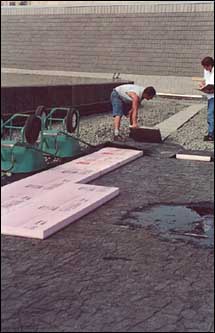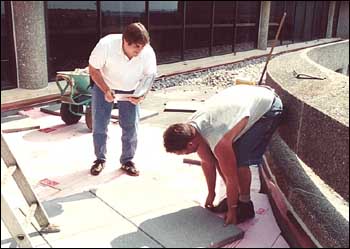Hot rubberized asphalt is system of choice for concrete buildings according to Virginia engineering firm

Most recently, Seal was retained by the architectural firm of Malesardi, Steiner, Keyes & McCummins to evaluate and recommend a suitable roof replacement for the American Institute of Architects Building in Washington, D.C.
When AIA first occupied its new headquarters in 1973, it found the building was designed with cast-in-place concrete decks for its 17,000-ft2 roof. It was originally protected with a built-up roof applied directly to the surface of a hot-applied asphaltic insulation. Some 17 years later, an EPDM roofing system was installed over recovery board on top of the BUR, and ballasted in place.

Roof pavers are placed next to extruded polystyrene insulation, which has an aged thermal value of R-5 per inch of thickness and excellent hydrophobic properties.
Seal recommended hot-applied, fabric-reinforced rubberized asphalt
Seal found the roof failing in several areas and recommended the removal of both failed roofing systems down to bare concrete, and replacement with a hot-applied, fabric-reinforced rubberized asphalt roofing system incorporating extruded polystyrene insulation.
The hot rubberizeed asphalt roofing system was selected over the conventional roof assembly for a concrete deck, which is usually a stack-up of deck, insulation board and roofing membrane. This conventional arrangement, according to Seals, is vulnerable to a hole, split or puncture, which can let water into the assembly. The water can then penetrate down to the concrete deck, and spread out over large areas of the roof.
In Seal's experience, one small leak can wet very large areas of insulation. The trapped water will deteriorate the membrane from the underside and unless the original insulation board was a hydrophobic type, such as extruded polystyrene, will cause the insulation to lose its R value and strength, making the roof very susceptible to blow-off. Leakage to the building interior can occur through a crack or penetration in the concrete roof deck far from the original leak point.
Hot rubberized asphalt membrane bonds directly to deck
The hot rubberized asphalt membrane bonds directly and fully to the concrete deck, preventing lateral migration of water. It is monolithic over the entire deck surface. It is an excellent vapor retarder, and remains flexible over a wide temperature range.
The insulation employed in a hot rubberized asphalt project must be very stable, with low absorption and a fairly limited thermal drift. The only type of insulation recommended for this application is extruded polystyrene.

Dave DiQuollo (left) of Seal Engineering helps Ed Tuite of Beta Roofing lay roof pavers over extruded polystyrene insulation.
For the replacement roof on the AIA building, Seal specified Owens Corning's FOAMULAR 404 rigid, extruded polystyrene insulation, which it says is an excellent partner in the rubberized asphalt roofing system. It is easy to handle, score and cut, and offers long-term thermal performance, with the aged thermal value of R-5 per inch of thickness and excellent hydrophobic properties (lack of moisture absorption). The specification was for 3-in. thick insulation, for a total R value of 16.67 for the roofing assembly.
The roofing system, which originated in Canada some 30 years ago, has an expected life of 30–35 years.
Milestone projects for Seal Engineering include repair and partial replacement of the Pentagon roof, a five-year project from design through the end of construction; replacement of the Lincoln and Jefferson Memorial roofs; and replacement of the roofing, siding and plaza waterproofing at the Ukranian Catholic National Shrine in Washington, DC.
Edited by Joyce Jungclaus, Editor, Public Works Online
Information provided by David J. DiQuollo, Seal Engineering
